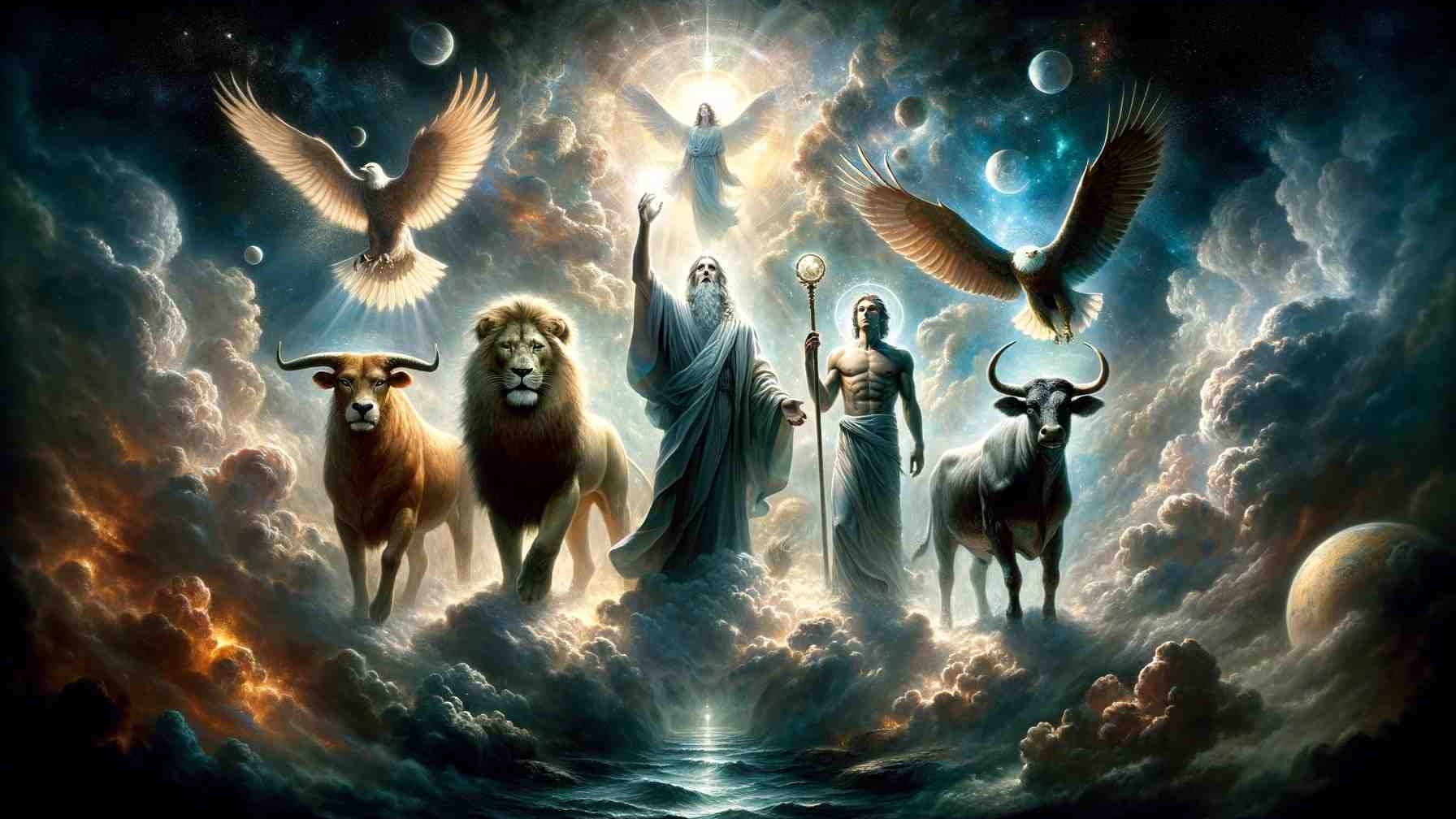Home>Christian Videos>Bible Stories>What Are The Four Gospels?


Bible Stories
What Are The Four Gospels?
Published: March 6, 2024
Jason DeRose, Managing Editor at Christian.net, uses his expertise in religion and journalism to deepen understanding of faith's societal impacts. His editorial leadership, coupled with a strong academic background, enriches the platform’s diverse content, earning him recognition in both journalism and religious circles.
Discover the four Gospels of the Bible, their significance, and their portrayal of the life and teachings of Jesus. Explore these timeless Bible stories and their impact on Christianity.
(Many of the links in this article redirect to a specific reviewed product. Your purchase of these products through affiliate links helps to generate commission for Christian.net, at no extra cost. Learn more)
Table of Contents
Introduction
So, what are the four Gospels? Well, the Gospels are the first four books of the New Testament in the Christian Bible. They are the books of Matthew, Mark, Luke, and John. These four books tell the story of the life, teachings, death, and resurrection of Jesus Christ. Each Gospel provides a unique perspective on the life and ministry of Jesus, offering valuable insights into his teachings and the impact he had on the world. Let's delve into each of these Gospels to understand their individual significance and contributions to the Christian faith.
The Gospel of Matthew
The Gospel of Matthew is the first book of the New Testament and is traditionally attributed to Matthew, one of Jesus' twelve disciples. This Gospel is particularly focused on presenting Jesus as the fulfillment of Old Testament prophecies, emphasizing his role as the long-awaited Messiah. The Gospel of Matthew begins with a genealogy tracing Jesus' lineage back to King David, highlighting his royal heritage. It also includes the famous Sermon on the Mount, where Jesus delivers key teachings such as the Beatitudes, which outline the blessings of the faithful. Additionally, the Gospel of Matthew contains numerous parables and miracles performed by Jesus, illustrating his divine authority and compassion. One of the most significant aspects of this Gospel is the Great Commission, where Jesus instructs his disciples to spread his teachings to all nations, laying the foundation for the global spread of Christianity. The Gospel of Matthew portrays Jesus as the rightful heir to the throne of David and the embodiment of God's promised salvation, making it a crucial text in understanding the identity and mission of Jesus Christ.
- The Gospel of Matthew emphasizes Jesus as the fulfillment of Old Testament prophecies.
- It begins with a genealogy tracing Jesus' lineage back to King David.
- Contains the Sermon on the Mount, which includes the Beatitudes.
- Portrays Jesus through parables and miracles, showcasing his divine authority and compassion.
- Concludes with the Great Commission, instructing disciples to spread Jesus' teachings globally.
The Gospel of Mark
The Gospel of Mark, attributed to John Mark, provides a concise and action-packed account of Jesus' ministry. It is the shortest of the four Gospels but is filled with vivid and dynamic storytelling. Mark wastes no time in introducing Jesus as the Son of God and the fulfillment of God's promises. The Gospel of Mark is characterized by its emphasis on Jesus' miracles and acts of healing, portraying him as a powerful and compassionate figure. It also highlights the humanity of Jesus, depicting his emotions, struggles, and moments of deep connection with his disciples. One of the key themes in the Gospel of Mark is the concept of discipleship and the cost of following Jesus. Mark presents Jesus as a revolutionary figure who challenges societal norms and calls for radical commitment from his followers. The Gospel of Mark concludes with the resurrection of Jesus, leaving readers with a sense of awe and wonder at the transformative power of his life and teachings.
- The Gospel of Mark is a concise and action-packed account of Jesus' ministry.
- It introduces Jesus as the Son of God and the fulfillment of God's promises.
- Emphasizes Jesus' miracles and acts of healing, portraying him as a powerful and compassionate figure.
- Highlights the humanity of Jesus, depicting his emotions, struggles, and moments of deep connection with his disciples.
- Explores the concept of discipleship and the cost of following Jesus.
- Concludes with the resurrection of Jesus, showcasing the transformative power of his life and teachings.
The Gospel of Luke
The Gospel of Luke, attributed to the physician and companion of the Apostle Paul, provides a detailed and comprehensive account of the life and ministry of Jesus. Luke's Gospel is known for its emphasis on compassion, inclusivity, and the universal nature of Jesus' message. It begins with the birth narratives of John the Baptist and Jesus, including the iconic story of the Nativity and the angelic proclamation to the shepherds. Luke's Gospel highlights Jesus' concern for the marginalized and oppressed, often featuring parables and encounters that emphasize God's love for all people, regardless of their social status or background. One of the distinctive features of the Gospel of Luke is the significant attention given to women, portraying them as active participants in Jesus' ministry and key witnesses to his teachings and miracles. Additionally, the Gospel of Luke contains unique parables such as the Good Samaritan and the Prodigal Son, which convey profound messages of forgiveness, mercy, and the boundless grace of God. Luke's Gospel also provides a detailed account of Jesus' journey to Jerusalem, his crucifixion, and ultimately, his resurrection, underscoring the redemptive and transformative power of his sacrificial death.
- The Gospel of Luke emphasizes compassion, inclusivity, and the universal nature of Jesus' message.
- It begins with detailed birth narratives of John the Baptist and Jesus, including the iconic story of the Nativity.
- Highlights Jesus' concern for the marginalized and oppressed, featuring parables and encounters that emphasize God's love for all people.
- Gives significant attention to women, portraying them as active participants in Jesus' ministry and key witnesses to his teachings and miracles.
- Contains unique parables such as the Good Samaritan and the Prodigal Son, conveying profound messages of forgiveness, mercy, and the boundless grace of God.
- Provides a detailed account of Jesus' journey to Jerusalem, his crucifixion, and ultimately, his resurrection, underscoring the redemptive and transformative power of his sacrificial death.
The Gospel of John
The Gospel of John stands out as a distinctive and profound account of the life and teachings of Jesus Christ. Written by the Apostle John, this Gospel delves deeply into the spiritual and theological dimensions of Jesus' identity. Unlike the synoptic Gospels, John's narrative focuses on presenting Jesus as the eternal Word of God incarnate, emphasizing his divine nature and role in creation. The Gospel of John opens with the majestic prologue, declaring, "In the beginning was the Word, and the Word was with God, and the Word was God." This powerful introduction sets the tone for the rest of the Gospel, highlighting Jesus' preexistence and his pivotal role in bringing light and life to humanity.
Throughout the Gospel of John, Jesus is portrayed as the embodiment of God's love and grace, offering salvation and eternal life to those who believe in him. The narrative is rich with profound discourses and dialogues, including the iconic "I am" statements, where Jesus declares his divine attributes and purpose. These statements, such as "I am the bread of life" and "I am the resurrection and the life," reveal the depth of Jesus' identity and the transformative power of faith in him.
One of the most poignant aspects of the Gospel of John is the emphasis on the intimate relationship between Jesus and his disciples. The account of the Last Supper, where Jesus washes the feet of his disciples and delivers his farewell discourse, showcases the depth of his love and the profound significance of his impending sacrifice. Additionally, the Gospel of John contains unique miracles, or "signs," such as the turning of water into wine and the raising of Lazarus, demonstrating Jesus' divine authority over creation and the promise of new life in him.
The Gospel of John reaches its climactic point with the crucifixion and resurrection of Jesus, portraying these events as the culmination of God's redemptive plan for humanity. John's account of the resurrection and the encounters with the risen Christ brings a message of hope and restoration, affirming the victory of light over darkness and the eternal significance of Jesus' mission.
In essence, the Gospel of John offers a profound and contemplative exploration of the person and work of Jesus Christ, inviting readers to embrace the transformative power of faith and experience the fullness of God's love and grace.
Read more: Who Were The Four Gospels Written To
Conclusion
In conclusion, the four Gospels—Matthew, Mark, Luke, and John—stand as foundational texts that provide unique and complementary perspectives on the life, teachings, and significance of Jesus Christ. Each Gospel contributes to the rich tapestry of the Christian faith, offering valuable insights into the identity, mission, and transformative power of Jesus. From the emphasis on Jesus as the fulfillment of Old Testament prophecies in Matthew to the action-packed storytelling and emphasis on discipleship in Mark, from the inclusive and compassionate portrayal of Jesus in Luke to the profound theological exploration of his divine nature in John, these Gospels collectively present a multifaceted portrait of the Son of God. Together, they form the cornerstone of Christian belief and continue to inspire and guide believers in their faith journey. The four Gospels not only recount the historical events of Jesus' life but also invite readers to encounter the living Christ and experience the profound impact of his teachings and redemptive work. As such, they remain central to the Christian tradition and continue to shape the hearts and minds of individuals and communities around the world.














